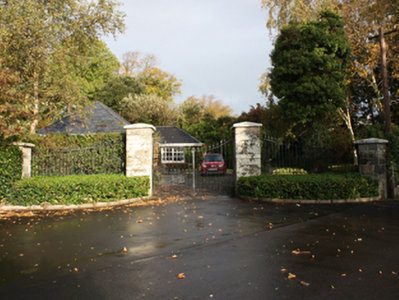Survey Data
Reg No
40820015
Rating
Regional
Categories of Special Interest
Architectural
Previous Name
Glen Gollen
Original Use
Demesne walls/gates/railings
In Use As
Gates/railings/walls
Date
1800 - 1840
Coordinates
234471, 426399
Date Recorded
15/10/2008
Date Updated
--/--/--
Description
Gateway originally serving Glengollan (house demolished), erected c. 1820, comprising a pair of tall ashlar gate piers (on square-plan) having cut stone capstones over, and with a pair of wrought-iron gates with arrow finials over, and with cast-iron decoration. Gateway flanked to either end (east and west) by curving sections of dwarf walling having cut stone coping and wrought-iron railings over with spear finials and cast-iron decoration, and terminated to either end by tall ashlar gate piers (on square-plan) having cut stone capstones over. Altered single-storey former gate lodge adjacent to the north-east (not in survey). Located adjacent to road to the south-east end of Fahan, and to the south-west of the site of Glengollan.
Appraisal
This good-quality if plain gateway originally served as the main formal entrance to Glengollan (house demolished). It probably originally dates to the early nineteenth-century, and survives in good condition despite the demise of the main house and other elements of the estate. The well-crafted and imposing gate piers are constructed using unusually high-quality ashlar masonry that provides an insight into the quality of Glengollan, and the wealth of the estate. It was the home of Thomas Norman who died in 1833, and Lewis (1837) records that this house was the residence of Charles Norman, Esq. at this time. It was later the residence of a Capt. Thomas Norman in 1894 (Slater’s Directory), High Sherriff of Donegal in 1864. His son Capt. Charles Norman, served as High Sherriff of Donegal but was killed in action at the Somme in 1917. The well-crafted wrought-iron gates and railings also survive in good condition, and are interesting and increasingly rare examples of traditional ironmongery. This well-detailed iron work creates an elegant visual contrast with the robust plain ashlar stone piers and the curved plinth wall. The simplicity of its lines and the quality of its stonework make it a handsome landmark along the roadscape to the south-east end of Fahan, and it acts as an historic reminder of Glengollan, and the Norman family. It originally marked the start of a long approach avenue to the house from the south-west. It forms a pair of structures with the now altered gate lodge adjacent to the north-east, and is an addition to the built heritage of the local area.







